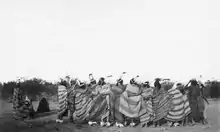Nivaclé
The Nivaclé are an indigenous people of the Gran Chaco. An estimated 13,700 Nivaclé people live in the President Hayes and Boquerón Departments in Paraguay, while approximately 200 Nivaclé people live in the Salta Province of Argentina.[2] A very small number of Nivaclé live in Tarija, Bolivia.

_bag_-_South_American_objects_in_the_American_Museum_of_Natural_History_-_DSC06043.JPG.webp) Nivaclé woven pouch, AMNH | |
| Total population | |
|---|---|
| 15,000–25,000 (2007)[1] | |
| Regions with significant populations | |
| 13,700 (1991) [2] | |
| 1,100 (2010) [3] | |
| 100[4] | |
| Languages | |
| Nivaclé, Spanish[2] | |
| Religion | |
| Animism, Christianity | |
In the last 50 years, 15,000 Mennonites from Canada, Russia, and Germany have settled in traditional Nivaclé territory.[1]
Groups
They have five subgroups, which are as follows:
- Tovoc Lhavos, river people: Chishamnee Lhavos, people from above
- Tovoc Lhavos, river people: Shichaam Lhavos, people from below
- Yita' Lhavos, forest people
- C'utjaan Lhavos, thorn people
- Jotoi Lhavos, people of the esparto grass
- Tavashai Lhavos, people of the savanna.[4]
Name
Nivaclé is an autonym, meaning "human."[4] They are also known as the Ashlushlay, Axluslay, Chulupí, and Nivaklé people.[2]
Language
They speak the Nivaclé language, which has two dialects: Forest Nivaclé and River Nivaclé. Nivaclé is one of the Mataco-Guaicuru languages. A dictionary has been published for the language, and the Bible was translated into Nivaclé in 1995.[2]
External links
| Wikimedia Commons has media related to Nivaclé people. |
- Hombre de Guerra, documentary (in Spanish)
Notes
- "Introduction." Nivaclé Foundation. Retrieved 3 July 2012.
- "Nivaclé." Ethnologue. Retrieved 3 August 2012.
- Censo Nacional de Población, Hogares y Viviendas 2010 Archived 2016-04-09 at the Wayback Machine
- "Nivaclé - Orientation." Countries and Their Cultures. Retrieved 3 August 2012.